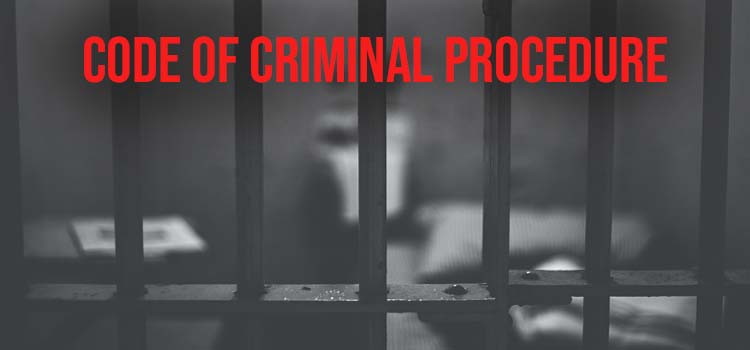CrPC: The Criminal Procedure Code, 1973
Posted On : August 8, 2022

Table of Contents
Where is it written that a person has to be arrested by police and not the MLA? How do you get bail in a criminal case? Does the same court hear criminal matters of murder and scratch injury? Where there is law, there is a plethora of doubts that follow among common man and even those in the legal field. There is one such law known as Indian Criminal Procedure Code which lays the process followed in and beyond courts during a criminal case trial. There are thousands of what, why, how, whom, etc. regarding the legal process after a crime is committed which have been answered through CrPC Act. It starts with understanding the nature of crime, who can register a police complaint, which court hears the matter, whether arrest can be made immediately or later, and so on. Find out what the Criminal Procedure Code, 1973 lays in this regard.
Some Important Terms to Understand Criminal Procedure Code
- Accused - A person who is suspected to have committed an offence (crime) as per the available proof (evidence).
- Prosecution - The party which invokes criminal procedure against the accused. For serious offences, it is said to be an offence against the state. Hence, trials are carried out by the state government. In case of petty/ minor offences, trial is proceeded with by the private parties aggrieved by such offence.
- Custody - When a person is kept in detention or protective care. Here under CrPC, the term is used for an accused person kept in police custody or judicial custody based on who is under control of such accused - police or the judicial magistrate.
- Bail - It can be understood as the temporary release of the accused person from custody while the trial is ongoing.
- Anticipatory Bail[1] - If the accused apprehends arrest in any criminal case which is cognizable, he/ she may seek anticipatory bail from concerned sessions or high court. A person who is granted anticipatory bail by the court can not be arrested by the police without a warrant.
Case Trial for Serious Crimes under Criminal Procedure Code, 1973 - Cognizable Offences
1. Whenever a crime is committed, it is one’s duty to inform the police (people rarely know about complaints to the Magistrate).
2. When people give information to police regarding commitment of an offence, police looks into the matter whether it is a serious offence or not (cognizable offences that are serious in nature like the offence of rape, murder, whereby a police officer can arrest without warrant[2]).
3. In case of cognizable offences, the police registers FIR (First Information Report[3]). In such cases, the police can start investigation of the matter without written official orders by the Magistrate[4].
4. Investigation by police under Section 156 CrPC includes collecting relevant evidence, recording statements of witnesses of offence, recording statements of the accused during interrogation, collecting items directly related to crime committed, etc.
5. The accused arrested by the police on suspicion through available direct evidence has to be presented before the Magistrate within 24 hours of arrest[5].
6. If further police interrogation is required with the accused, such accused may be retained in police custody. Otherwise, the Magistrate may order judicial custody. (In case of police custody, max. limit is 15 days while investigation and interrogation may continue under the police control. In judicial custody, it may be stretched for 60-90 days. Further interrogation with the accused during judicial custody requires police to seek permission from the magistrate having control over the accused’s custody).
7. Once the investigation is complete, a police report (commonly termed as chargesheet) is handed over to the case magistrate. The chargesheet contains all the relevant evidence to prove a criminal case against the accused person.
8. If a detailed investigation by the police reveals that there is no reasonable ground of evidence against the accused, he may be released, or be forwarded before the concerned Magistrate[6].
9. All the necessary documents along with the chargesheet are also handed over to the accused. Thereafter, the trial begins as per Code of Criminal Procedure, 1973. Framing of charges takes place as per sections 211 to 214 of CrPC to give the accused a clarity on offences charged against him/ her.
10. Based on the jurisdiction, trial goes under the magistrate court or sessions court, as the case process in criminal case allows.
11. The accused may plead guilty as per charges framed, i.e. accept that he committed the said offences. After this, the accused person is convicted (legally confirmed as an offender of the said crime) and punishment is decided accordingly.
12. The accused can apply to the high court for quashing the FIR if the same has been lodged with malicious intention.
13. If the accused does not plead guilty but trial, the prosecution (the other party against whom offence is committed, it is the state government in case of serious offences) presents evidence against the accused before the court.
14. The trial goes on whereby the accused’s statements are recorded (examination in chief under section 303 of Indian Criminal Procedure Code), witness’ statements are recorded and all of them are cross-examined by the criminal attorneys of opposite parties as well.
15. After all the evidence, witness and accused examinations, cross-examinations or re-examinations are in place, there takes place the final argument between defence and prosecution.
16. Based on the final arguments and supporting evidence, the presiding officer, i.e. the judge passes his/ her judgment. If the accused is found guilty, i.e. all the evidence points towards commitment of offence by him/ her, he/ she is convicted and the judge proclaims the punishment as per applicable laws.
17. If the judge finds that the evidence available is not enough to prove the accused guilty, such an accused is acquitted, i.e. released as free from the charges.
18. In any case, whether the accused is convicted or acquitted, there is scope for appeal to the higher courts against such decision.
CrPC Trial for Non-Serious Offences
1. If the nature of crime committed falls under the non-cognizable umbrella (cheating, defamation, etc.), i.e. an offence whereby the police can not legally arrest a person without warrant, an NC report is registered (Non-Cognizable Report[7]).
2. In such cases, the police are legally restricted from arresting the accused or investigating the matter.
3. The NC report is forwarded to the magistrate who may order commencement of investigation by the concerned police officer.
4. Section 155 of Criminal Procedure Code lays that if two or more offences are reported and one of them is a serious - cognizable offence, such a case is investigated as a cognizable offence and the police officer in charge can not be questioned.
5. In case of non-cognizable or non-serious offences, direct complaint to the magistrate is also an option, specially in cases whereby police deny registration of an FIR or complaint.
6. If the magistrate registers the complaint and finds it necessary to have a proper investigation, he/ she may order the same to the concerned police officer under 156(3) CrPC.
7. Magistrate is also rightful to carry out an inquiry and proceed with personal examination of the persons involved.
8. If there is no sufficient ground in the complaint, the magistrate may dismiss such a criminal complaint.[8]
9. If there is sufficient evidence to proceed with the case, the process may begin with issues. Summons are served to compel the appearance of parties concerned. If the concerned person does not appear before the court, warrants[9] may also be issued for arrest. Default to the prior two may result in declaration of such accused person to have absconded and his/ her property may be attached to force appearance before the court.
10. If the accused timely appears before the court, bail bond is secured and trial begins.
11. In case of summons trial, charges are not framed against the accused.
12. Further, the collection of evidence and final argument goes on all the way as above and the matter is decided.
Criminal Procedure Code - Important Provisions
- Schedule 1 of the CrPC 1973 clarifies whether an offence is cognizable or non-cognizable, bailable or non-bailable and which court has the jurisdiction to hear a particular offence.
- It is the right of an accused to have a legal representative during trial before the court. If it is a criminal case registered in Kolkata police station, having a criminal lawyer in Kolkata by the side can save the legal interests of the accused.
- The Indian Criminal Procedure Code not only lays the criminal procedure for the Penal Code. Provisions like CrPC 125 lays provide for maintenance to wife, children and aged parents as well. It provides that if the concerned person does not hand over dutiful maintenance to the wife/ children or parents, he/ she may be prosecuted under the Criminal Procedure Code and forced legally to pay such amount.
- During trial, the accused goes under ‘examination in chief’ whereby his attorney asks some questions and his responses are recorded. Thereafter, the other side, i.e. the prosecution can cross examine the accused based on the statements pre-recorded. This helps the court establish the truth in case of discrepancy (when statements do not match).
- Statements of witnesses and their cross examination by the other side of lawyers also helps the court establish the truth behind the offence committed.
- There is a rule of double jeopardy under Article 20 (1) of the Constitution of India, 1950 and Section 300 of the Code of Criminal Procedure, 1973. It lays that no person will go through the criminal process twice for one particular offence. Hence, if a theft was committed against A and B and the case was heard in the trial court as complained of by A, the same will not be complained again by B to have another trial.
- Some offences are said to be compoundable which means compromise among defence and prosecution sides to end the criminal trial. Serious offences are not compoundable unless the high court or the hon'ble Supreme Court allow in special circumstances.
Find Criminal Procedure Code pdf with latest amendments and CrPC sections list - Click here.
[1] Section 438 of CrPC 1973.
[2] Section 41 of the Code of Criminal Procedure, 1973.
[3] Section 154 of the Code of Criminal Procedure, 1973.
[4] Section 156 of CrPC 1973.
[5] Section 57 of the Code of Criminal Procedure.
[6] Section 169 CrPC.
[7] Section 155 of Criminal Procedure Code, 1973.
[8] Section 203 of Code of Criminal Procedure, 1973.
[9] Section 70-81 of CrPC 1973.
























